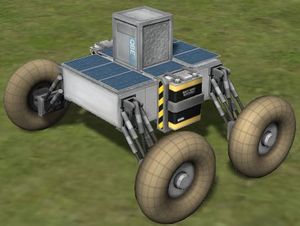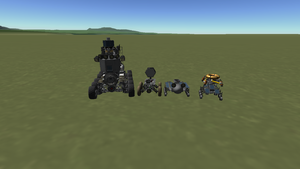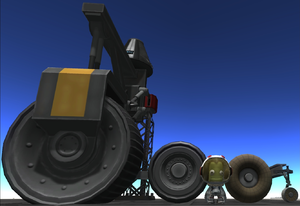Difference between revisions of "Rover"
(→Piloting rovers: repairing rover wheels) |
(→Gallery) |
||
| (65 intermediate revisions by 23 users not shown) | |||
| Line 1: | Line 1: | ||
| − | + | [[File:Rover.jpg|right|thumb|A simple solar-powered, unmanned rover. The QBE is not needed anymore as of [[1.6]]]] | |
| + | [[File:AllStockRovers.png|thumb|All the stock rovers in-game]] | ||
| + | A '''rover''' is a vehicle equipped with [[wheels]] and some means of lateral propulsion (usually powered wheels) allowing it to move across terrestrial surfaces. Rovers can be driven everywhere except [[Kerbol]] and [[Jool]], although they are difficult to operate in the extremely low gravity of small moons. The parts necessary to construct rovers were introduced with {{version|0.19}}. | ||
== Constructing rovers == | == Constructing rovers == | ||
=== Basics === | === Basics === | ||
| + | For a vehicle to be classified as a rover, it must have at the very least a [[command module]] and some wheels. A source of [[electricity]] is strongly recommended as no command module has enough internal supply for more than a few minutes of driving. To allow the vehicle to drive straight, the wheels must be mounted parallel to each other in the [[VAB]] which can be achieved by setting the symmetry mode to “mirror” by pressing {{Key press|R}}, or building it in the [[SPH]]. While the rover is being driven, the wheels are smart enough to steer in directions matching the control inputs. | ||
| − | + | Wheels require lots of electricity to operate, so a rover should be equipped with plenty of energy. [[Battery|Batteries]] can power a rover for a time, but sustainable energy sources in form of [[solar panel]]s or [[RTG]]s are required for a rover to operate indefinitely. Often solar panels are preferred due to their lower mass, but extended solar panels can easily be destroyed by atmospheric drag when on a fast-driving rover in an [[atmosphere]]. | |
| − | + | When attaching multiple in-line wheels radially to a flat body, such as the [[Probodobodyne RoveMate]], it is important to turn angle snap off in the construction menu. Otherwise, the wheels will not attach themselves properly at any point on the rover but the exact center and always point tangentially. | |
| + | |||
| + | [[File:Rover-wheel-compare.png|right|thumb|300px|Rover wheels model XL3, TR-2L, M1 and S2 with a Kerbal for size comparison]] | ||
| + | {{Stats Table Wheels}} | ||
=== Advanced === | === Advanced === | ||
| − | To | + | To be stable and easy to control, a rover should be relatively wide with a low [[center of mass]]. This makes it much harder for the rover to tip over when accelerating, braking, or turning at speed. Rovers become less stable as gravity decreases, so a rover which is perfectly stable driving around the [[KSC]] might be easy to flip on [[Minmus]], for example. Another hazard of bodies with low gravity like Minmus is that rovers with a low mass might not exert enough pressure on their wheels to grip the ground and accelerate. One solution to this problem is to use upward-pointing [[RCS]] thrusters to push the rover into the surface. |
| − | On small rovers, [[LT-1 Landing Strut]]s can be used to turn them back over when they end up upside down. Larger rovers on low-gravity worlds can help | + | Alternatively, rather than trying to avoid flipping entirely, a rover can be designed to right itself. On small rovers, retractable [[LT-1 Landing Strut]]s can be used to turn them back over when they end up upside down. Larger rovers on low-gravity worlds can help themselves up by using [[Reaction Control System|RCS thrusters]]. Rovers can also turn themselves over with torque from [[reaction wheel]]s or their [[command module]], though having reaction wheels apply torque while driving the rover can also make it more prone to flipping in the first place. [[Action groups]] can be used to turn off reaction wheels for normal driving, or probe cores which lack reaction wheels, such as the [[Probodobodyne OKTO2]], can be used. |
| − | + | The most complex rovers are practically small spacecraft, using [[rocket engine]]s to deorbit and land themselves or even return themselves to orbit and carrying multiple [[kerbonaut]]s or other large payloads. | |
== Piloting rovers == | == Piloting rovers == | ||
| − | + | By default, a rover is controlled with the keys {{Key press|W}}, {{Key press|A}}, {{Key press|S}}, & {{Key press|D}}. Unfortunately these keys also control vehicle rotation, which can make a rover completely uncontrollable on planets with low gravity. As a workaround for this problem, the rover controls can be remapped to different keys in the Settings menu. If a number pad is available, a good solution is to map the {{Key press|W}}{{Key press|A}}{{Key press|S}}{{Key press|D}} drive controls to {{Key press|8}}{{Key press|4}}{{Key press|5}}{{Key press|6}} on the numpad. Another solution is to switch into docking mode when controlling a rover. | |
| + | |||
| + | [[File:Docking lin.png|thumb|Docking controls in “LIN” mode]] | ||
| + | Using docking controls, as opposed to staging controls, it is possible to quickly switch which keys to control the translation and rotation. When the controls are in “ROT” mode the {{Key press|W}}{{Key press|A}}{{Key press|S}}{{Key press|D}} controls rotate the rover, which can be switched with space. In “LIN” mode, the keys {{Key press|I}}, {{Key press|J}}, {{Key press|K}}, & {{Key press|L}} rotate and {{Key press|W}}{{Key press|A}}{{Key press|S}}{{Key press|D}} translate, which is usually harmless for a rover. With a single click of the {{Key press|Space}} key, pitching can be easily switch between on and off, therefore giving a stable mode of acceleration/direction change and a quick way to adjust the pitch of the rover on low gravity planets, should it be tipped or launched over a hill. | ||
| + | |||
| + | To prevent rovers from driving away when they are dropped, the parking brake (in the top-center HUD, bottom icon on the right) should be applied prior to the drop. While piloting the rover the {{Key press|B}} key (by default) can activate the brake, but after releasing the button the brakes will release too. | ||
| + | |||
| + | The most flimsy part of a rover is the wheels. When they experience strong impacts, they can get “broken”. In this state they are still intact as a part, but do not work as a wheel anymore. The impact threshold for this to happen is a lot lower than the actual impact tolerance listed in the parts menu. Wheels easily break when the rover jumps, so it is recommended to reduce the speed when the rover is driving over a hill. They can also break when they get faster than the maximum speed of the wheels, which can easily happen when it drives down a slope or uses rocket thrusters to accelerate a rover to higher speeds than it could reach with its wheels only. But it is possible to raise the speed at which the wheels break by reducing the weight pushing on the wheels, for example in atmosphere by using [[wing]]s. | ||
| + | |||
| + | Fortunately, broken wheels can be fixed by [[engineer]]s on an [[EVA]]. When an engineer is close to the damaged wheel, right-click it and click on "repair". The wheel will immediately be operational again. Usually the wheel jumps a bit which can damage the rover, especially if it is moving or very light. | ||
| + | |||
| + | {{clear|right}} | ||
| − | + | == Gallery == | |
| + | <gallery> | ||
| + | File:Rover recovery module .png|Modified rover from [[Rover + Skycrane]] with reusable lander in the background. | ||
| + | File:Minmus Rover.jpeg|A rover on [[Minmus]] requiring extra down force by using [[RCS]]. | ||
| + | File:Minmus Humvee.png|Another rover on Minmus. | ||
| + | File:Long Range Rover Minmus.png|Heavy rovers can drive on Minmus without RCS. | ||
| + | File:Syphax Summit.jpg|A rover on a large mountain on [[Duna]]. | ||
| + | File:Rovers_on_duna.png|Various rovers connected on Duna. | ||
| + | File:A Rover with 4 Kerbals.png|A rover with 4 [[Kerbonaut|Kerbonauts]]. | ||
| + | </gallery> | ||
| − | |||
| − | + | [[Category:Craft]] | |
Latest revision as of 22:36, 1 March 2023

A rover is a vehicle equipped with wheels and some means of lateral propulsion (usually powered wheels) allowing it to move across terrestrial surfaces. Rovers can be driven everywhere except Kerbol and Jool, although they are difficult to operate in the extremely low gravity of small moons. The parts necessary to construct rovers were introduced with version 0.19.
Constructing rovers
Basics
For a vehicle to be classified as a rover, it must have at the very least a command module and some wheels. A source of electricity is strongly recommended as no command module has enough internal supply for more than a few minutes of driving. To allow the vehicle to drive straight, the wheels must be mounted parallel to each other in the VAB which can be achieved by setting the symmetry mode to “mirror” by pressing R, or building it in the SPH. While the rover is being driven, the wheels are smart enough to steer in directions matching the control inputs.
Wheels require lots of electricity to operate, so a rover should be equipped with plenty of energy. Batteries can power a rover for a time, but sustainable energy sources in form of solar panels or RTGs are required for a rover to operate indefinitely. Often solar panels are preferred due to their lower mass, but extended solar panels can easily be destroyed by atmospheric drag when on a fast-driving rover in an atmosphere.
When attaching multiple in-line wheels radially to a flat body, such as the Probodobodyne RoveMate, it is important to turn angle snap off in the construction menu. Otherwise, the wheels will not attach themselves properly at any point on the rover but the exact center and always point tangentially.
| Image | Part | Radial size | Cost ( |
Mass (t) |
Max. Temp. (K) |
Tolerance (m/s) |
Tolerance (g) |
Electricity (⚡/s) |
Max. Motor Speed (m/s) |
Brake Torque (kNm) |
|---|---|---|---|---|---|---|---|---|---|---|
| RoveMax Model S2 | Radial mounted | 300 | 0.05 | 1 200 | 20 | 20 | 1.0 | 12 | 0.34 | |
| RoveMax Model M1 | Radial mounted | 450 | 0.075 | 1 200 | 50 | 50 | 2.5 | 34 | 2 | |
| TR-2L Ruggedized Vehicular Wheel | Radial mounted | 760 | 0.105 | 1 200 | 100 | 80 | 3.5 | 58 | 3 | |
| RoveMax Model XL3 | Radial mounted | 1 200 | 1.25 | 1 200 | 150 | 200 | 5.0 | 15.5 | 30 |
Advanced
To be stable and easy to control, a rover should be relatively wide with a low center of mass. This makes it much harder for the rover to tip over when accelerating, braking, or turning at speed. Rovers become less stable as gravity decreases, so a rover which is perfectly stable driving around the KSC might be easy to flip on Minmus, for example. Another hazard of bodies with low gravity like Minmus is that rovers with a low mass might not exert enough pressure on their wheels to grip the ground and accelerate. One solution to this problem is to use upward-pointing RCS thrusters to push the rover into the surface.
Alternatively, rather than trying to avoid flipping entirely, a rover can be designed to right itself. On small rovers, retractable LT-1 Landing Struts can be used to turn them back over when they end up upside down. Larger rovers on low-gravity worlds can help themselves up by using RCS thrusters. Rovers can also turn themselves over with torque from reaction wheels or their command module, though having reaction wheels apply torque while driving the rover can also make it more prone to flipping in the first place. Action groups can be used to turn off reaction wheels for normal driving, or probe cores which lack reaction wheels, such as the Probodobodyne OKTO2, can be used.
The most complex rovers are practically small spacecraft, using rocket engines to deorbit and land themselves or even return themselves to orbit and carrying multiple kerbonauts or other large payloads.
Piloting rovers
By default, a rover is controlled with the keys W, A, S, & D. Unfortunately these keys also control vehicle rotation, which can make a rover completely uncontrollable on planets with low gravity. As a workaround for this problem, the rover controls can be remapped to different keys in the Settings menu. If a number pad is available, a good solution is to map the WASD drive controls to 8456 on the numpad. Another solution is to switch into docking mode when controlling a rover.
Using docking controls, as opposed to staging controls, it is possible to quickly switch which keys to control the translation and rotation. When the controls are in “ROT” mode the WASD controls rotate the rover, which can be switched with space. In “LIN” mode, the keys I, J, K, & L rotate and WASD translate, which is usually harmless for a rover. With a single click of the Space key, pitching can be easily switch between on and off, therefore giving a stable mode of acceleration/direction change and a quick way to adjust the pitch of the rover on low gravity planets, should it be tipped or launched over a hill.
To prevent rovers from driving away when they are dropped, the parking brake (in the top-center HUD, bottom icon on the right) should be applied prior to the drop. While piloting the rover the B key (by default) can activate the brake, but after releasing the button the brakes will release too.
The most flimsy part of a rover is the wheels. When they experience strong impacts, they can get “broken”. In this state they are still intact as a part, but do not work as a wheel anymore. The impact threshold for this to happen is a lot lower than the actual impact tolerance listed in the parts menu. Wheels easily break when the rover jumps, so it is recommended to reduce the speed when the rover is driving over a hill. They can also break when they get faster than the maximum speed of the wheels, which can easily happen when it drives down a slope or uses rocket thrusters to accelerate a rover to higher speeds than it could reach with its wheels only. But it is possible to raise the speed at which the wheels break by reducing the weight pushing on the wheels, for example in atmosphere by using wings.
Fortunately, broken wheels can be fixed by engineers on an EVA. When an engineer is close to the damaged wheel, right-click it and click on "repair". The wheel will immediately be operational again. Usually the wheel jumps a bit which can damage the rover, especially if it is moving or very light.
Gallery
Modified rover from Rover + Skycrane with reusable lander in the background.
A rover on a large mountain on Duna.
A rover with 4 Kerbonauts.











